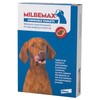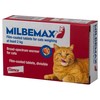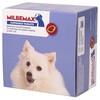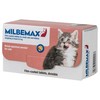Milbemax
Milbemax Worming Tablets can be used for the treatment of mixed infections by immature and adult cestodes and nematodes in cats and dogs. A broad spectrum wormer, the tablets contain 2 active ingredients that have been chosen due to their proven efficacy against most types of intestinal worms.
Milbemax can also be used the for the treatment and prevention of heartworm in cats and dogs, and for the treatment and prevention of lungworm in dogs.
Milbemax Chewable Worming Tablets for Adult Dogs
£4.00Milbemax Chewable Worming Tablets are an easy to administer treatment for dogs weighing at least 5kg, for mixed infections of adult cestodes and nematodes including roundworms, tapeworms,...[More info]
Milbemax Worming Tablets for Adult Dogs
£3.65Milbemax Worming Tablets are indicated for the treatment of mixed infections by adult cestodes and nematodes including roundworms, tapeworms, hookworms and whipworms, in dogs weighing at...[More info]
Milbemax Worming Tablets for Adult Cats
£3.40Milbemax Worming Tablets are indicated for the treatment of mixed infections by adult cestodes and nematodes including roundworms, tapeworms and hookworms, in cats weighing at least 2kg....[More info]
Milbemax Chewable Worming Tablets for Small Dogs and Puppies
£1.55Milbemax Chewable Worming Tablets are an easy to administer treatment for dogs weighing at least 1kg, for mixed infections of adult cestodes and nematodes including roundworms, tapeworms,...[More info]
Milbemax Worming Tablets for Small Dogs and Puppies
£1.60Milbemax Worming Tablets are indicated for the treatment of mixed infections by adult cestodes and nematodes including roundworms, tapeworms, hookworms and whipworms, in dogs weighing at...[More info]
Milbemax Worming Tablets for Small Cats and Kittens
£1.75Milbemax Worming Tablets are indicated for the treatment of mixed infections by adult cestodes and nematodes including roundworms, tapeworms and hookworms, in cats weighing 0.5 – 2kg....[More info]
Contraindications
Do not use in case of hypersensitivity to the active substances or to any of the excipients
See also point "Special precautions for use"
Special warnings for each target species
Studies with milbemycin oxime indicate that the margin of safety in certain dogs of Collie or related breeds is less than in other breeds. In these dogs, the recommended dose should be strictly observed.
The tolerance of MILBEMAX in young puppies from these breeds has not been investigated.
Clinical signs in Collies are similar to those seen in the general dog population when overdosed (see overdose section).
Special precautions for use in animals
Dog
As per good veterinary practice, animals should be weighed to ensure accurate dosing
Treatment of dogs with a high number of circulating microfilariae can sometimes lead to the appearance of hypersensitivity reactions, such as pale mucous membranes, vomiting, trembling, laboured breathing or excessive salivation. These reactions are associated with the release of proteins from dead or dying microfilariae and are not a direct toxic effect of the product. The use in dogs suffering from microfilaremia is thus not recommended.
In heartworm risk-areas, or in the case it is known that a dog has been travelling to and from heartworm risk regions, before using MILBEMAX, a veterinary consultation is advised to exclude the presence of any concurrent infestation of Dirofilaria immitis. In the case of a positive diagnosis, adulticidal therapy is indicated before administering Milbemax.
Echinococcosis represents a hazard for humans. In case of Echinococcosis, specific guidelines on the treatment and follow up and on the safeguard of persons have to be followed. Experts or institutes of parasitology should be consulted.
No studies have been performed with severely debilitated dogs or individuals with seriously compromised kidney or liver function. The product is not recommended for such animals or only according to a benefit/risk assessment by the responsible veterinarian.
In dogs less than 4 weeks old, tape worm infection is unusual. Treatment of animals less than 4 weeks old with a combination product may therefore not be necessary.
Parasite resistance to any particular class of anthelmintic may develop following frequent, repeated use of an anthelmintic of that class
Cat
As per good veterinary practice, animals should be weighed to ensure accurate dosing.
Echinococcosis represents a hazard for humans. In case of Echinococcosis, specific guidelines on the treatment and follow up and on the safeguard of persons have to be followed. Experts or institutes of parasitology should be consulted.
No studies have been performed with severely debilitated cats or individuals with seriously compromised kidney or liver function. The product is not recommended for such animals or only according to a benefit/risk assessment by the responsible veterinarian.
Special precautions to be taken by the person administering the veterinary medicinal product to animals
Wash hands after use.
In the event of accidental ingestion of the tablets, particularly by a child, seek medical advice immediately and show the package leaflet or the label to the doctor.
Adverse reactions (frequency and seriousness)
Dog
In very rare occasions, systemic signs (such as lethargy), neurological signs (such as muscle tremors and ataxia) and/or gastrointestinal signs (such as emesis, diarrhea, anorexia and drooling have been observed in dogs after administration of the veterinary medicinal product.
Cat
In very rare occasions, especially in young cats, systemic signs (such as lethargy), neurological signs (such as ataxia and muscle tremors) and/or gastrointestinal signs (such as emesis and diarrhoea) have been observed after administration of the veterinary medicinal product.
Use during pregnancy, lactation or lay
The product may be used in breeding dogs including pregnant and lactating bitches.
MILBEMAX can be used in breeding cats including pregnant and lactating queens.
Interaction with other medicinal products and other forms of interaction
The concurrent use of MILBEMAX with selamectin is well tolerated. No interactions were observed when the recommended dose of the macrocyclic lactone selamectin was administered during treatment with MILBEMAX at the recommended dose. In the absence of further studies, caution should be taken in the case of concurrent use of MILBEMAX and other macrocyclic lactones. Also, no such studies have been performed with reproducing animals.
Although not recommended, the concomitant use of MILBEMAX with a spot on containing moxidectin and imidacloprid at recommended dose rates following a single application was well tolerated in one laboratory study in 10 kittens.
Overdose (symptoms, emergency procedures, antidotes), if necessary
In case of overdose, in addition to signs observed at the recommended dose (see "Adverse reactions"), drooling was observed. This sign will usually disappear spontaneously within a day.
Withdrawal period(s)
Not applicable





